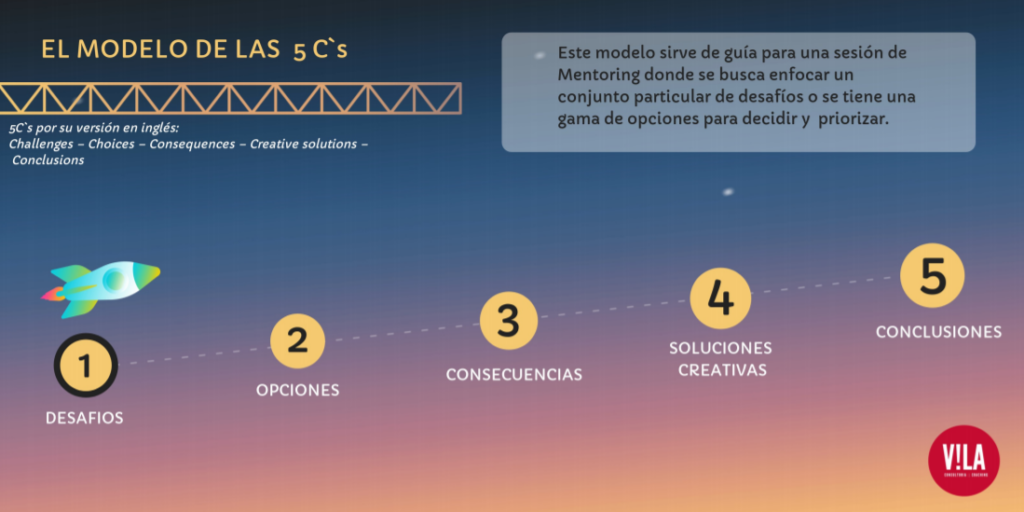5 C'S MODEL
As you well know in a mentoring sessionthe mentor is unable to provide solutions to problems or blockages that the entrepreneur encounters on his way to accelerate his business.
The method of 5C is a tool very useful in mentoring, since, facilitates the mentor's way to help to the entrepreneur without providing solutions, provoking reflection and learning in the entrepreneur. Mike Pegg described a five-stage process within a Mentoring session.
The 5Cs are named after the five steps described in the English version of the 5Cs.
- Challenges: identify the problem or blockage.
- Choices: the entrepreneur proposes solutions.
- Consequences: the entrepreneur analyses the pros and cons of each solution.
- Creative solutions: the mentor helps to discover more solutions, providing experience and expertise
- Conclusions: final decision.

The central idea of this method is facilitate a systemic review of the current situation, the options and the consequences of taking one or the other option. This structured process allows the entrepreneur to discover for him/herself the best course of action through a set of questions ordered in five stages.
Challenges, challenges, problems:
Main problem, challenge or blockage, the most important and most urgent that does not allow the mentee to move forward.
TYPICAL QUESTIONS ASKED BY THE MENTOR:
- What is the first challenge you would like to explore?
- Can you give me a picture of what is happening?
- What would be a positive outcome you hope for?
OPTIONS:
Describe the options the mentee is considering to address the problem.
IT IS THE MENTEE WHO PROPOSES THE SOLUTIONS, THE MENTOR ONLY ASKS QUESTIONS:
- What do you see as your possible options for dealing with the challenge?
- What have you tried before and what were the consequences?
- What do you think would happen if you did nothing?
CONSEQUENCES:
Evaluation of the pros and cons of each option. The mentor assists the mentoree in anticipating the consequences of choosing one option over another.
- What are the advantages and disadvantages if you take the search for option A,B,C?
- How desirable are the expected outcomes?
- Can you face the negative consequences of such a choice, and is it worth it?
Use of graphs to rank and rate each of the possible solutions (from 1 to 10) and reflect on the ranking.
CREATIVE SOLUTIONS:
At this stage, AND ONLY AT THIS STAGE, the mentor may suggest alternative solutions that the mentee is not able to see for him/herself. Explore other available options that appear during the conversation.
The mentor supports from its experience and expertisehelping in the search for creative alternatives and the sharing of good practices.
- Is it possible to take the best parts of each option and create a new path? What would this look like?
- Have you ever been in a similar situation in the past and succeeded? What did you do?
- Are there other individuals, teams or companies that have successfully managed this type of challenge?
- What did they do to manage it successfully?
- What would you do if you could start tomorrow from scratch?
CONCLUSIONS:
Recap of the options discussed, their consequences and a decision on what to do next. Closing with a concrete actionable, clear commitment within a set timeframe.
Let's explore the option you have chosen:
- What will be the advantages?
- What will be the disadvantages?
TAKING INTO ACCOUNT THESE CONSEQUENCES:
- Are you ready to move on?
- What steps do you need to take to achieve your goals/results?
- How can you take these steps? When do you want to start?
- What can you do to get some early successes?
Even if the answer to these questions involves a long and obstacle-filled process, it is recommended to generate a healthy sense of urgency by closing this meeting by asking questions: What is the you have to start doing tomorrow to begin this journey?
SHORT PRACTICE WITH A HYPOTHETICAL MENTORING SESSION
One person plays the role of an entrepreneur, showing a start-up problem and the mentor tries to apply the method.
- Challenge: The entrepreneur explains to his mentor that they are having problems with the staff as they are demotivated.
- Alternatives: The mentor will help the entrepreneur to think about the available alternatives or options to overcome the challenge. The mentor may ask "what are the options"?
THE ENTREPRENEUR SAYS:
- I can fire them.
- I can ask them to fill in a staff satisfaction survey.
- I can increase your salary by 5%.
- I can ask everyone to come and talk to me.
CONSEQUENCES:
The mentor will support the entrepreneur in examining the consequences of these decisions. The mentor can ask the entrepreneur "what are the advantages and disadvantages of the four options you have mentioned". The entrepreneur should then explore each option in more detail, and this process should be guided by the mentor.
Creative solutions: Once the best option has been determined, the mentor can work with the entrepreneur and discuss creative solutions. This is a mutual and collaborative approach.
The mentor can then help by sharing with the entrepreneur any knowledge on the subject or even his/her own experiences, in order to arrive at a practical solution.
TYPICAL PROBLEMS OF AN ENTREPRENEUR IN PRACTISING THE 5C'S
ENTREPRENEURIAL PROBLEMS
CHALLENGE: INCREASED COMPETITION IN THE MARKET
OPTIONS:
- Increase marketing and advertising.
- Reduce prices.
INCREASE THE QUALITY OF THE PRODUCT OR SERVICE
CONSEQUENCES:
- Increase marketing and advertising: It can attract new customers, but it can also be costly and may not guarantee an increase in sales.
- Reduce prices: It may attract customers with a limited budget, but it may decrease the cost-effectiveness and perceived quality of the product or service.
INCREASE THE QUALITY OF THE PRODUCT OR SERVICE: THIS CAN IMPROVE CUSTOMER PERCEPTION AND DIFFERENTIATE FROM THE COMPETITION, BUT CAN BE COSTLY AND TIME-CONSUMING.
CREATIVE SOLUTIONS:
- Offer a package of products or services that the competition does not offer.
- Identify and focus on a specific market niche.
- Partner with complementary companies to create integrated solutions.
CHALLENGE: CASH FLOW PROBLEMS
OPTIONS:
- Obtain a loan.
- Reduce costs.
INCREASE REVENUES:
CONSEQUENCES:
- Obtain a loan: May provide needed liquidity in the short term, but can be high interest and increase debt.
- Reduce costs: It may improve profitability in the short term, but it may affect the quality of the product or service and diminish the ability to compete in the market.
INCREASE REVENUES: CAN IMPROVE PROFITABILITY AND MARKET POWER, BUT MAY REQUIRE SIGNIFICANT TIME AND EFFORT.
CREATIVE SOLUTIONS:
- Offer additional services that complement the main product.
- Set up a pay-per-service subscription instead of a pay-per-product subscription.
- Partner with complementary companies to offer integrated solutions.
CHALLENGE: PERSONNEL MANAGEMENT ISSUES
OPTIONS:
- Dismiss problematic employees.
- Provide further training and professional development.
IMPLEMENTING SERVICES AND REWARDS
CONSEQUENCES:
- Dismiss problematic employees: It can improve the working environment and productivity, but it can be costly and time-consuming to find suitable replacements.
- Provide further training and professional development: It can improve the quality of work and employee loyalty, but it can be costly and time-consuming.
IMPLEMENTING INCENTIVES AND REWARDS: CAN MOTIVATE EMPLOYEES AND IMPROVE THE QUALITY OF WORK, BUT CAN BE COSTLY AND MAY NOT GUARANTEE BEHAVIOURAL CHANGE
CREATIVE SOLUTIONS:
- Set individual and team targets and reward based on performance.
- Provide online training and development instead of expensive in-person training.
- Offer flexible working hours and remote working options to attract and retain high quality employees.
EXAMPLE 1: PROBLEM WITH MARKETING STRATEGY
- Challenges: The company is having difficulty reaching new customers and its marketing strategy is not working.
- Choices: The entrepreneur proposes two options: increase investment in advertising or improve the quality of content on social networks.
- Consequences: The mentor helps the entrepreneur to analyse the pros and cons of each option. Increasing investment in advertising could be costly and does not guarantee new customers. Improving the quality of content on social media may take time, but can be more effective in attracting potential customers.
- Creative solutions: The mentor suggests that entrepreneurs explore new ways of reaching their target audience, such as collaborating with influencers or organising events related to their product or service.
- Conclusions: After analysing the options, the entrepreneur decides to focus on improving the quality of content on social media and finding new ways to reach his target audience.
EXAMPLE 2: PROBLEM WITH EQUIPMENT MANAGEMENT
- Challenges: The company is having problems with the team and there are conflicts between members.
- Choices: The entrepreneur proposes two options: dismiss the problematic members or hire a mediator to help resolve conflicts.
- Consequences: The mentor helps the entrepreneur to analyse the pros and cons of each option. Firing problematic members could negatively affect productivity and create a bad atmosphere in the team. Hiring a mediator might be costly, but can help resolve conflicts and improve collaboration among team members.
- Creative solutions: The mentor suggests that the entrepreneur explore new ways to foster collaboration and teamwork, such as organising social events for the team or implementing a soft skills training programme.
- Conclusions: After analysing the options, the entrepreneur decides to hire a mediator to help resolve conflicts and improve collaboration between team members. He will also implement a soft skills training programme for the team.
TASK
CASE STUDY
Challenge: The entrepreneur explains to his mentor that they are having problems with the staff as they are demotivated.
Alternatives:
- I can fire them.
- I can ask them to fill in a staff satisfaction survey.
- I can increase your salary by 5%.
- I can ask everyone to come and talk to me.
Consequences:
The mentor will support the entrepreneur in examining the consequences of these decisions. The mentor can ask the entrepreneur "what are the advantages and disadvantages of the four options you have mentioned". The entrepreneur should then explore each option in more detail, and this process should be guided by the mentor.
Creative solutions:
Once the best option has been determined, the mentor can work with the entrepreneur and discuss creative solutions. This is a mutual and collaborative approach.
The mentor can then help by sharing with the entrepreneur any knowledge on the subject or even his/her own experiences, in order to arrive at a practical solution.
Learning method:
- Read through the 5Cs in mentoring and their application in a hypothetical mentoring session.
- Practice applying the 5Cs method to a problem or challenge you have in your company or project.
- Reflect on the advantages of using such a method in mentoring and how it can help you arrive at a practical and effective solution.
- Find real case studies of the application of the 5Cs method in mentoring and analyse their outcome.
QUIZ
After the question and before think of yourself.
You can also consult other Related TIPs.
Learn more about mentoring by downloading this free EBOOK.
Do you want to help an entrepreneur by sharing your experience as a MENTOR? get accredited now.
Are you an entrepreneur? If you need support to boost your business, apply now for your mentor.
Rate this TIP!
Click on the stars to rate
Rating "73" - Average " - Average4.7"
No votes yet, be the first to vote!
We are sorry you did not find it useful.
Help us improve this TIP!
Leave us a comment and tell us how you would improve this TIP











Support and challenge the mentee to carry out agreed actions.
Hello,
Just to comment on a couple of typos in the text that can be misleading, it is just after the paragraph that starts with Mike Pegg and lists the 5 steps of the 5Cs:
Consequences; the metee analyses the pros and cons of each solution.....Es mentee
Creative solutions; the mentee helps to discover more solutions.....It is the mentor not the mentee who helps to discover more solutions.
Greetings.
MAribel thank you very much, it's fixed!
Very useful for mentoring sessions .... and for oneself.
For me, this model is the basis of almost all mentoring sessions, as entrepreneurs inevitably raise their personal issues in the sessions. It avoids turning the mentor into the "Helena Francis" of the mentoring sessions, it forces the entrepreneur to explore different options and to take full responsibility for his or her final decisions.